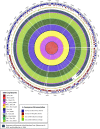Genomic Stability and Phenotypic Characteristics of Industrially Produced Lacticaseibacillus rhamnosus GG in a Yogurt Matrix
- PMID: 34613788
- PMCID: PMC8612286
- DOI: 10.1128/AEM.01575-21
Genomic Stability and Phenotypic Characteristics of Industrially Produced Lacticaseibacillus rhamnosus GG in a Yogurt Matrix
Abstract
Lacticaseibacillus rhamnosus GG is a widely marketed probiotic with well-documented probiotic properties. Previously, deletion of the mucus-adhesive spaCBA-srtC1 genes in dairy isolates was reported. In this study, we examined the genome preservation of industrially produced L. rhamnosus GG (DSM 33156) cofermented in yogurts. In total, DNA of 66 samples, including 60 isolates, was sequenced. Population samples and 59 isolates exhibited an intact genome. One isolate exhibited loss of spaCBA-srtC1. In addition, we examined phenotypes related to the probiotic properties of L. rhamnosus GG either from frozen pellets or cofermented in yogurt. L. rhamnosus GG from frozen pellets induced a response in intestinal barrier function in vitro, in contrast to frozen pellets of the starter culture. Yogurt matrix, containing only the starter culture, induced a response, but cofermentation with L. rhamnosus GG induced a higher response. Conversely, only the starter culture stimulated cytokine secretion in dendritic cells, and it was observed that the addition of L. rhamnosus GG to the starter culture reduced the response. We conclude that the L. rhamnosus GG genome is preserved in yogurt and that common in vitro probiotic effects of L. rhamnosus GG are observed when examined in the yogurt matrix. IMPORTANCELacticaseibacillus rhamnosus GG is a well-documented probiotic strain recognized for its high acid and bile tolerance and properties of adhesion to enterocytes and mucus. The strain exhibits SpaCBA pili, which have been demonstrated to play an important role in adhesion and therefore are relevant for persistence in the gastrointestinal tract. Recently we demonstrated that the genome and phenotypes of L. rhamnosus GG are preserved throughout an industrial production pipeline. However, as gene deletions in L. rhamnosus GG were previously reported for isolates from dairy products, a key question on the genomic stability of L. rhamnosus GG in a yogurt matrix remained. The aim of this study was to analyze genome stability and phenotypic characteristics of L. rhamnosus GG in yogurt. We found that the genome of L. rhamnosus GG is well conserved when the organism is cofermented in yogurt. Some phenotypic characteristics are consistent in all product matrixes, while other characteristics are modulated.
Keywords: Lacticaseibacillus rhamnosus GG; SpaCBA; genome stability; industrial fermentation; probiotics; yogurt.
Figures







References
-
- Isolauri E, Juntunen M, Rautanen T, Sillanaukee P, Koivula T. 1991. A human Lactobacillus strain (Lactobacillus casei sp strain GG) promotes recovery from acute diarrhea in children. Pediatrics 88:90–97. - PubMed
Publication types
MeSH terms
Grants and funding
LinkOut - more resources
Full Text Sources

